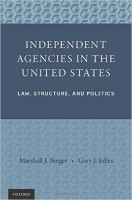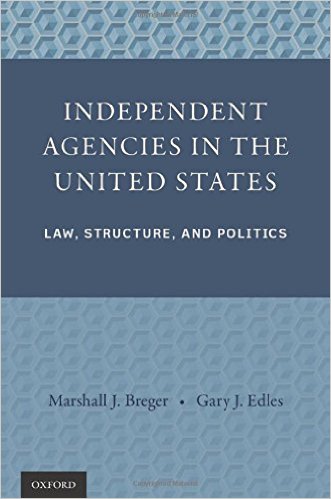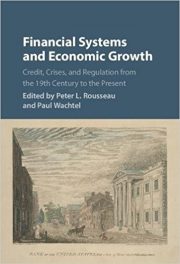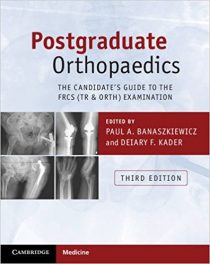 Authors: Marshall J. Breger and Gary J. Edles
Authors: Marshall J. Breger and Gary J. Edles
Publisher: Oxford University Press – 562 pages
Book Review by: Paiso Jamakar
The average person likely does not know that there are 35 entities at the federal (for the non-U.S. reader: national) level of government that have enormous power over the private sector. They are tasked with various functions. They are called “independent agencies.” We’ll get to why they are considered “independent” in a bit, but first, something about what they are and what they do.
Some of these bodies or panels of people are well known, such as the Federal Trade Commission (FTC) that overseas and regulates commerce at the top level of government, and the Securities and Exchange Commission (SEC) which monitors stock trading nationwide. But there are obscure ones such as the Federal Mine Safety and Health Review Commission, and the National Indian Gaming Commission which the average person likely never heard of.
These 35 entities are known collectively as “the headless fourth branch of government,” in addition to the other three branches: the executive, legislative and judicial. They are all actually part and parcel of the super-huge government bureaucracy of the United States at the national level that, according to the Congressional Budget Office, currently employs over 23.6 million people and spends nearly $3.7 trillion in a 12-month period from October 1st to September 30th.
The salaries and benefits of the people who work at these 35 agencies are paid with tax revenues of the Federal government, so they are in essence, part of the government.
The amount spent by the U.S. Federal government has exceeded total revenues for many years now. This is called deficit spending. But particularly in the 81–month period since January 20, 2009, when Barack Obama was sworn in as president, up to today, October 26, 2015, the total deficit spending has totaled nearly $7.8 trillion or about $1.154 trillion every 12-month period since then. This has resulted in an increase in the Federal government’s debt from $10.626 trillion then, to $18.419 trillion today.
While Federal deficit spending is not part of the subject of this book, we mention these figures so the reader may know the high price of government, including regulations, which adds to prices of goods and services sold by the United States, making U.S. companies less competitive in the international marketplace, and has impelled them to establish offices overseas.
Essentially what makes these agencies – named in the Appendices of this book – independent is that they do not belong to any part of the bureaucracy of the three branches of government. The terms of office of the heads and other employees of these agencies are typically longer than the term of the president of the United States, and they cannot be easily removed.
The authors – Marshall J. Breger and Gary J. Edles – point out the general conflict between political accountability and agency independence, with chapters named below which gives you the reader an overview of what you will find in this book:
- Introduction
- How the Independent Agency Developed: The Search for Expertise
- Theory of Agency Independence
- The Modern Agency: Structure and Appointments
- The Modern Agency: Removal Protection as an Indicator of Independence
- The Modern Agency: Other Indicia of Independence
- Institutional Design: The Tension Between Autonomy and Accountability
- Further Along on the Continuum: Governmental; Functions and Private Enterprise
- Internal Agency Operations
- The Independent Agency as an Institutional Art Form: Comparative Examples
- Conclusion: The Future of the Independent Agency
The authors also compare and contrast these U.S. independent agencies with those of the United Kingdom and the European Union.
This is an enlightening and useful book for those interested in governments and governance, particularly in entities described as “independent agencies.”
Authors:
Marshall J. Breger has been a Professor of Law at the Columbus School of Law of the Catholic University of America since 1995. During 1991-1993 he served as Solicitor of Labor, the chief lawyer of the Department of Labor, and during 1992 he served concurrently as Acting Assistant Secretary of Labor for Management Standards.
From 1985 to 1991 he was Chairman of the Administrative Conference of the United States and from 1983 to 1985 he was a Special Assistant to President Ronald Reagan. From 1982 to 1983 and from 1993 to 1995 he was a Senior Fellow at the Heritage Foundation. He is a 1973 graduate of the University of Pennsylvania Law School. And in 1973-74 he was Law Clerk for the Hon. Marvin Frankel, United States Judge for the Southern District of New York.
Gary J. Edles is a Fellow in Administrative Law and Adjunct Professor at American University, Washington College of Law, and a Visiting Professor at the University of Hull Law School. He has a 28-year career as a senior U.S. government lawyer, including service at three independent multimember agencies.
He was also General Counsel of the Administrative Conference of the United States. He earned his law degree from New York University Law School and holds LLM and SJD degrees from George Washington University Law School. He is coauthor of two books and author or coauthor of numerous articles on the administrative process.







